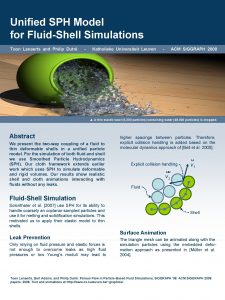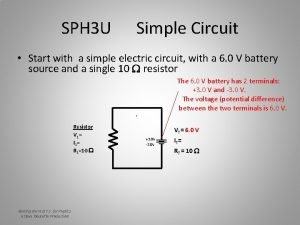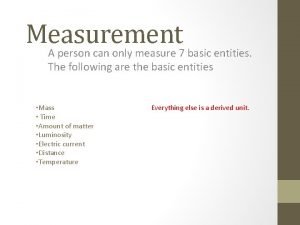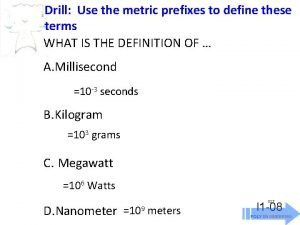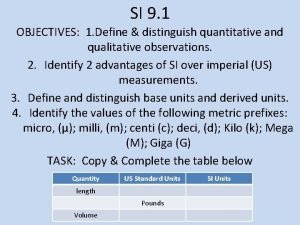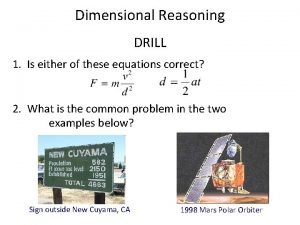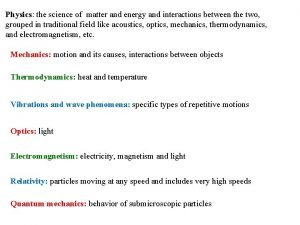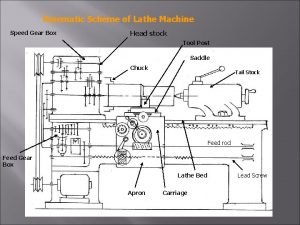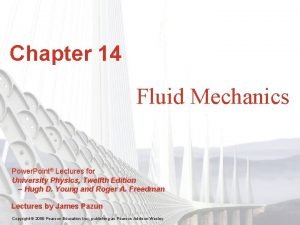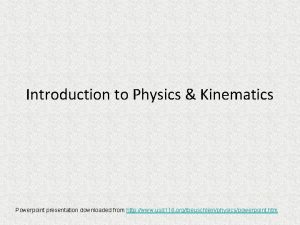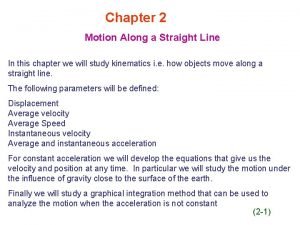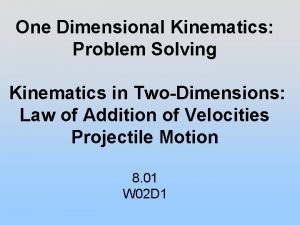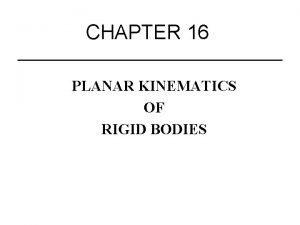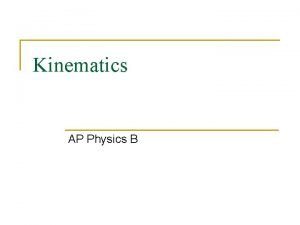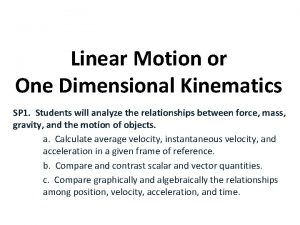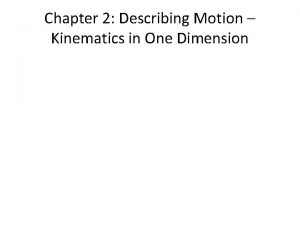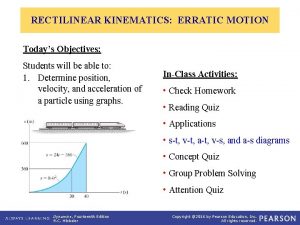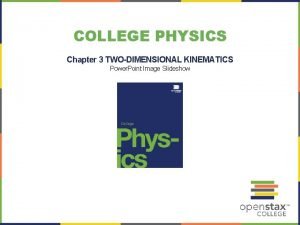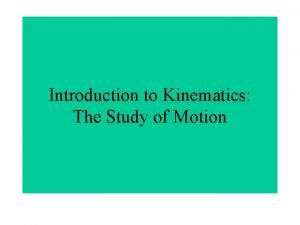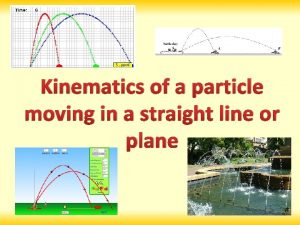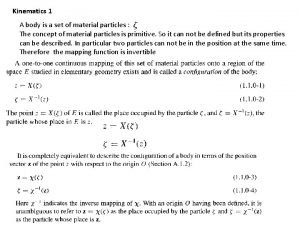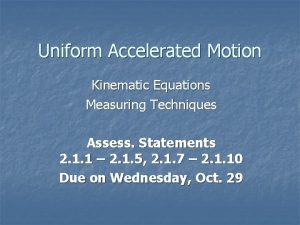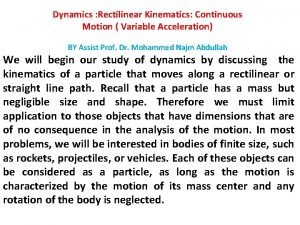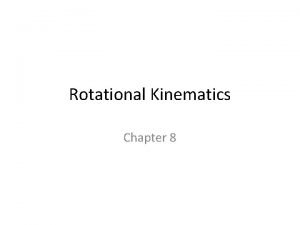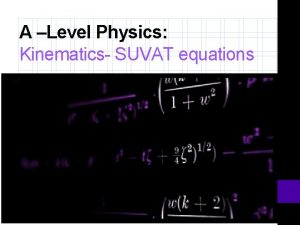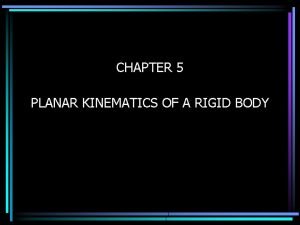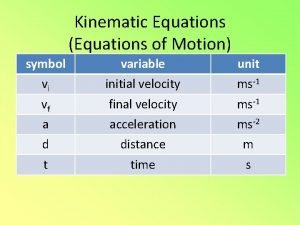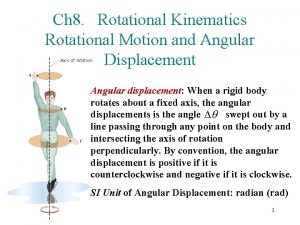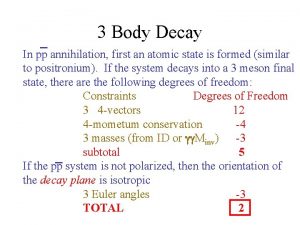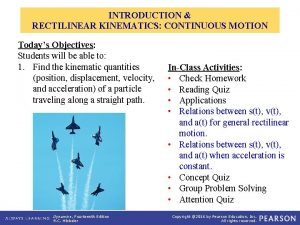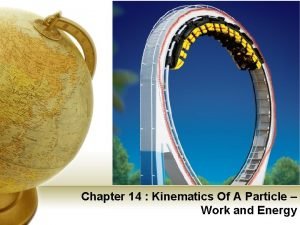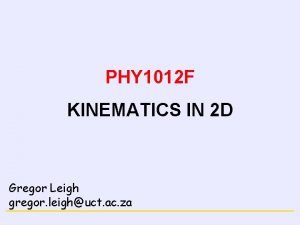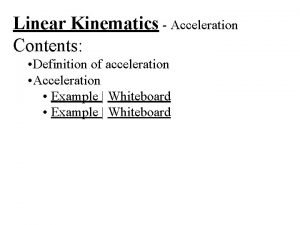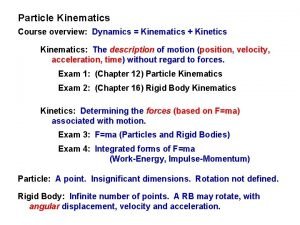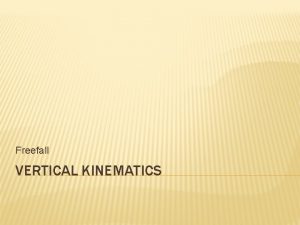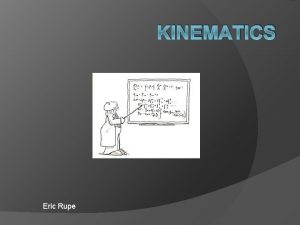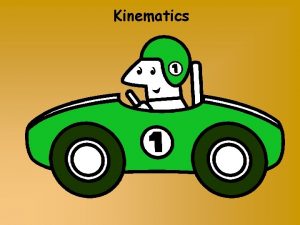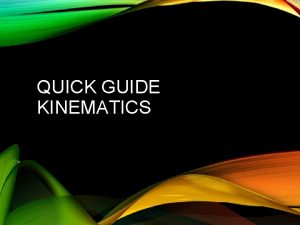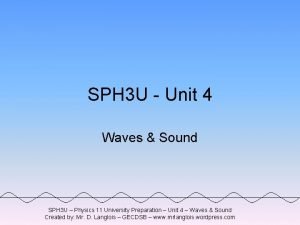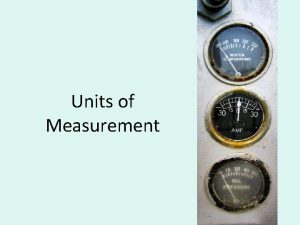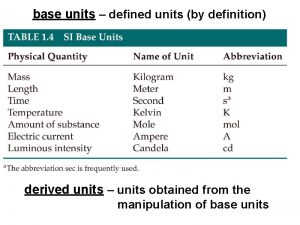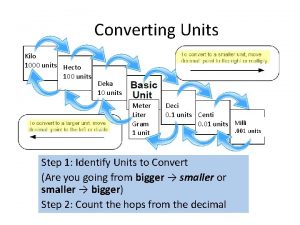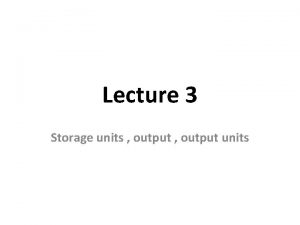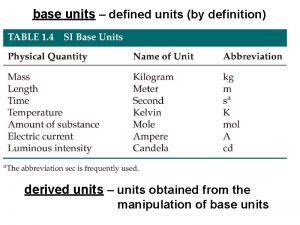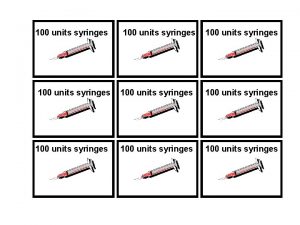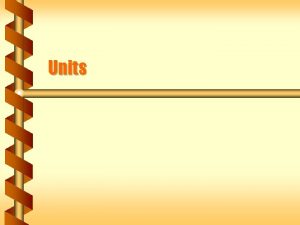SPH 4 U 1 Kinematics Fundamental Units l















































- Slides: 47

SPH 4 U 1 “Kinematics”

Fundamental Units l l How we measure things! All things in classical mechanics can be expressed in terms of the fundamental units: l l Length: L Mass : m Time : t For example: l Speed has units of L / t (e. g. kilometres per hour). l Force has units of m. L / t 2 (kgm/s 2 )etc. . .

Units. . . l SI (Système International) Units: l mks: L = meters (m), M = kilograms (kg), T = seconds (s) l cgs: L = centimeters (cm), M = grams (gm), T = seconds (s) l We will use mostly SI mks units, but you may run across some problems using cgs units. You should know to convert back & forth.

Dimensional Analysis l This is a very important tool to check your work l It’s also very easy! l Example: Doing a problem you get the answer distance d = vt 2 (velocity x time 2) Units on left side = L Units on right side = L / t x t 2 = L x t l Left units and right units don’t match, so answer must be wrong!!

Vectors l A vector is a quantity that involves both magnitude and direction. 55 km/h [N 35 E] l A downward force of 3 Newtons l l A scalar is a quantity that does not involve direction. 55 km/h l 18 cm long l

Vector Notation l Vectors are often identified with arrows in graphics and labeled as follows: We label a vector with a variable. This variable is identified as a vector either by an arrow above itself : Or By the variable being BOLD: A

Displacement is an object’s change in position. Distance is the total length of space traversed by an object. 1 m 3 m 6. 7 m Start = 500 m Finish 5 m Displacement: Distance: Displacement = 0 m Distance = 500 m

Vector Addition A R E B R E C B DA D E D R C A C B A + B + C + D + E = Distance R = Resultant = Displacement

Rectangular Components Quadrant II y Quadrant I A R -x Quadrant III B Quadrant IV -y x

Vectors. . . l The components (in a particular coordinate system) of r, the position vector, are its (x, y, z) coordinates in that coordinate system l r = (rx , ry , rz ) = (x, y, z) l Consider this in 2 -D (since it’s easier to draw): where r = |r | l rx = r cos l ry = r sin (x, y) y arctan( y / x ) r x

Vectors. . . l The magnitude (length) of r is found using the Pythagorean theorem: r y x l The length of a vector clearly does not depend on its direction.

Resultant of Two Forces • force: action of one body on another; characterized by its point of application, magnitude, line of action, and sense. • Experimental evidence shows that the combined effect of two forces may be represented by a single resultant force. • The resultant is equivalent to the diagonal of a parallelogram which contains the two forces in adjacent legs. • Force is a vector quantity.

Resultant of Several Concurrent Forces • Concurrent forces: set of forces which all pass through the same point. A set of concurrent forces applied to a particle may be replaced by a single resultant force which is the vector sum of the applied forces. • Vector force components: two or more force vectors which, together, have the same effect as a single force vector.

Sample Problem • Graphical solution - construct a parallelogram with sides in the same direction as P and Q and lengths in proportion. Graphically evaluate the resultant which is equivalent in direction and proportional in magnitude to the diagonal. Two forces act on a bolt at A. Determine their resultant. • Trigonometric solution - use the triangle rule for vector addition in conjunction with the law of cosines and law of sines to find the resultant.

Components l l l Resolve both forces into their horizontal and vertical components Px =40 N cos 20 Py = 40 N sin 20 Qx = 60 N cos 25 Qy = 60 N sin 25

Add the x components l Add the y components l Use pythagorean theorem to find magnitude l Use the arc tan to solve for direction l

1 -D kinematics l l Velocity v is the “rate of change of position” Average velocity vav in the time t = t 2 - t 1 is: x x trajectory x 2 Vav = slope of line connecting x 1 and x 2. x 1 t 2 t t

1 -D kinematics. . . l l Consider limit t 1 t 2 Instantaneous velocity v is defined as: so v(t 2) = slope of line tangent to path at t 2. x x x 2 x 1 t 2 t t

1 -D kinematics. . . l l Acceleration a is the “rate of change of velocity” Average acceleration aav in the time t = t 2 - t 1 is: a = v 2 –v 1 t 2 -t 1

Recap l So for constant acceleration we find: x v a t t t

Recap: l For constant acceleration:

Problem Solving Tips: l l l Read Carefully! l Before you start work on a problem, read the problem statement thoroughly. Make sure you understand what information is given, what is asked for, and the meaning of all the terms used in stating the problem. Using what you are given, set up the algebra for the problem and solve for your answer algebraically l USE symbols for quantities you know as needed l Don’t plug in numbers until the end Watch your units ! l Always check the units of your answer, and carry the units along with your formula during the calculation.

1 -D Free-Fall l l This is a nice example of constant acceleration (gravity): In this case, acceleration is caused by the force of gravity: l Usually pick y-axis “upward” y l Acceleration of gravity is “down”: t v t a y ay = g t

Gravity facts: l g does not depend on the nature of the material! l Galileo (1564 -1642) figured this out without fancy clocks & rulers! l On the surface of the earth, gravity acts to give a constant acceleration l demo - feather & penny in vacuum l Nominally, g = 9. 81 m/s 2 l l At the equator g = 9. 78 m/s 2 At the North pole g = 9. 83 m/s 2

Gravity facts: l l l It’s a force between two objects, like me and the earth. or earth and moon, or sun and Neptune, etc Gravitational Force is proportional to product of masses: Proportional to 1/r 2 At the surface of earth gravitational force attracts “m” toward the center of the earth, is approximately constant and equal to mg. The number g=9. 81 m/s 2 contains the effect of Mearth and rearth.

Question: l The pilot of a hovering helicopter drops a lead brick from a height of 1000 m. How long does it take to reach the ground and how fast is it moving when it gets there? (neglect air resistance) 1000 m

Solution: l First choose coordinate system. l Origin and y-direction. l Next write down position equation: 1000 m l Realize that v 0 y = 0. y y=0

Solution: l Solve for time t when y = 0 given that y 0 = 1000 m l Recall: l Solve for vy: y y=0

1 D Free Fall l (a) Alice and Bob are standing at the top of a cliff of height H. Both throw a ball with initial speed v 0, Alice straight down and Bob straight up. The speed of the balls when they hit the ground are v. A and v. B respectively. Which of the following is true: v. A < v. B (b) v. A = v. B Alice v 0 v. A v. B (c) v. A > v. B Bob H

1 D Free fall l Since the motion up and back down is symmetric, intuition should tell you that v = v 0 l We can prove that your intuition is correct: Equation: Bob v 0 H v = v 0 This looks just like Bill threw the ball down with speed v 0, so the speed at the bottom should be the same as Alice’s ball. y=0

2 -D Kinematics l Most 2 -D problems when acceleration is constant: l Choose y axis to be along direction of acceleration l Choose x axis to be along the “other” direction of motion l Example: Throwing a baseball (neglecting air resistance) l Acceleration is constant (gravity) l Choose y axis up: ay = -g l Choose x axis along the ground in the direction of the throw

“x” and “y” components of motion are independent. A man on a train tosses a ball straight up in the air. ØView this from two reference frames: Reference frame on the moving train. l Reference frame on the ground.

Problem: l David clobbers a fastball toward center-field. The ball is hit 1 m (yo ) above the plate, and its initial velocity is 36. 5 m/s (v ) at an angle of 30 o ( ) above horizontal. The center-field wall is 113 m (D) from the plate and is 3 m (h) high. l l What time does the ball reach the fence? Does David get a home run? v y 0 h D

Problem. . . l l Choose y axis up. Choose x axis along the ground in the direction of the hit. Choose the origin (0, 0) to be at the plate. Say that the ball is hit at t = 0, x(0) = x 0 = 0. y(0) = y 0 = 1 m l Equations of motion are: vx = v 0 x x = v xt vy = v 0 y - gt y = y 0 + v 0 y t - 1/ 2 gt 2

Problem. . . l Use geometry to figure out v 0 x and v 0 y : y g v y 0 Find and v 0 x = |v| cos . v 0 y = |v| sin . v 0 y remember, we were told that q = 30 deg x

Problem. . . l l The time to reach the wall is: t = D / vx (easy!) We have an equation that tell us y(t) = y 0 + v 0 y t + a t 2/ 2 So, we’re done. . now we just plug in the numbers: a = -g Find: l vx = 36. 5 cos(30) m/s = 31. 6 m/s l vy = 36. 5 sin(30) m/s = 18. 25 m/s l t = (113 m) / (31. 6 m/s) = 3. 58 s l y(t) = (1. 0 m) + (18. 25 m/s)(3. 58 s) - (0. 5)(9. 8 m/s 2)(3. 58 s)2 = (1. 0 + 65. 3 - 62. 8) m = 3. 5 m l Since the wall is 3 m high, David gets the homer!!

Motion in 2 D l l Two footballs are thrown from the same point on a flat field. Both are thrown at an angle of 30 o above the horizontal. Ball 2 has twice the initial speed of ball 1. If ball 1 is caught a distance D 1 from the thrower, how far away from the thrower D 2 will the receiver of ball 2 be when he catches it? Assume the receiver and QB are the same height (a) D 2 = 2 D 1 (b) D 2 = 4 D 1 (c) D 2 = 8 D 1

Solution l The distance a ball will go is simply x = (horizontal speed) x (time in air) = v 0 x t To figure out “time in air”, consider the equation for the height of the ball: l l When the ball is caught, y = y 0 (time of catch) two solutions (time of throw)

Solution l So the time spent in the air is proportional to v 0 y : l Since the angles are the same, both v 0 y and v 0 x for ball 2 are twice those of ball 1. v 0, 2 ball 1 v 0 x , 1 l v 0, 1 v 0 y , 2 ball 2 v 0 y , 1 v 0 x , 2 Ball 2 is in the air twice as long as ball 1, but it also has twice the horizontal speed, so it will go 4 times as far!!

Projectile Motion Range Distance: Travel Time: Height Maximum: Time to top:

Example A golfer hits a golf ball so that it leaves the club with an initial speed v 0=37. 0 m/s at an initial angle of 0=53. 1 o. a) Determine the position of the ball when t=2. 00 s. b) Determine when the ball reaches the highest point of its flight and find its height, h, at this point. c) Determine its horizontal range, R. a) The x-distance: The y-distance:

Example A golfer hits a golf ball so that it leaves the club with an initial speed v 0=37. 0 m/s at an initial angle of 0=53. 1 o. a) Determine the position of the ball when t=2. 00 s. b) Determine when the ball reaches the highest point of its flight and find its height, h, at this point. c) Determine its horizontal range, R.

Shooting the Monkey (tranquilizer gun) l Where does the zookeeper aim if he wants to hit the monkey? ( He knows the monkey will let go as soon as he shoots ! )

Shooting the Monkey. . . l If there were no gravity, simply aim at the monkey r =v 0 t r = r 0

Shooting the Monkey. . . l With gravity, still aim at the monkey! r = v 0 t - 1/ 2 g t 2 r = r 0 - 1/2 g t 2 Dart hits the monkey!

Recap: Shooting the monkey. . . x = v 0 t y = -1/2 g t 2 l This may be easier to think about. It’s exactly the same idea!! They both have the same Vy(t) in this case x = x 0 y = -1/2 g t 2

Shooting the Monkey
 Aplusphysics kinematics-horizontal kinematics
Aplusphysics kinematics-horizontal kinematics Ohsu sph
Ohsu sph Sph saxion
Sph saxion Sph toon
Sph toon Sph 4 inches
Sph 4 inches Netgear sph
Netgear sph Sph surface tension
Sph surface tension Sph +3
Sph +3 Sph cah toa
Sph cah toa 7 fundamental units
7 fundamental units Metric prefixes definition
Metric prefixes definition Si standard units
Si standard units Dimensional homogeneity
Dimensional homogeneity 7 fundamental si units
7 fundamental si units Unit viscosity
Unit viscosity When units manufactured exceed units sold:
When units manufactured exceed units sold: Speywood units vs botox units
Speywood units vs botox units Lathe
Lathe Fluid statics ppt
Fluid statics ppt Kinematics ppt
Kinematics ppt Motion along the straight line
Motion along the straight line Swerve drive kinematics
Swerve drive kinematics One dimensional kinematics problems
One dimensional kinematics problems General plane motion
General plane motion Kinematics all formulas
Kinematics all formulas Kinematics in one dimension
Kinematics in one dimension Describing motion kinematics in one dimension
Describing motion kinematics in one dimension Rectilinear kinematics
Rectilinear kinematics Kinematics
Kinematics Kinematics ppt
Kinematics ppt Introduction of kinematics
Introduction of kinematics Kinematics of a particle moving in a straight line
Kinematics of a particle moving in a straight line Transport theorem kinematics
Transport theorem kinematics Kinematic equations rearranged
Kinematic equations rearranged Uniformly accelerated motion formula
Uniformly accelerated motion formula 4 linear motion equations
4 linear motion equations Suvat equations physics
Suvat equations physics Tempus robotics
Tempus robotics Closed chain kinematics
Closed chain kinematics Planar kinematics of a rigid body
Planar kinematics of a rigid body Kinematic equations symbols
Kinematic equations symbols Rotational kinematics
Rotational kinematics 3 body decay
3 body decay Rectilinear kinematics: continuous motion
Rectilinear kinematics: continuous motion Kinematics of a particle
Kinematics of a particle Range motion
Range motion Linear kinematics examples
Linear kinematics examples Forward kinematics
Forward kinematics



